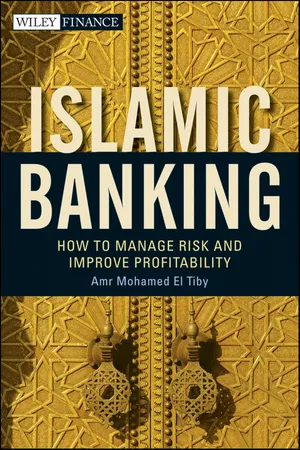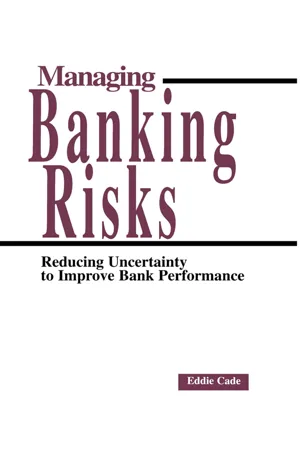Economics
Capital Adequacy Management
Capital adequacy management refers to the process by which financial institutions ensure they have enough capital to cover potential losses and risks. It involves maintaining a balance between risk and capital, as well as complying with regulatory requirements. Effective capital adequacy management is crucial for the stability and resilience of financial institutions, as it helps protect against insolvency and financial crises.
Written by Perlego with AI-assistance
Related key terms
5 Key excerpts on "Capital Adequacy Management"
- eBook - ePub
Islamic Banking
How to Manage Risk and Improve Profitability
- Amr Mohamed El Tiby Ahmed(Author)
- 2010(Publication Date)
- Wiley(Publisher)
In late 1981, a new framework for capital adequacy was developed by the three federal regulatory agencies. The framework included a definition of capital and guidelines for capital adequacy measurement. The new framework divided capital into primary capital, which consists of items that are permanent in nature, and secondary capital, which includes items that are nonpermanent in nature. The framework classified financial institutions into three categories according to their adequacy of capital, in addition to setting the minimum level of primary capital in the total capital.There were two major criticisms to the use of the capital-to-asset ratio: (1) it encourages banks to move into investing in a higher risk asset, as it has the same capital required for lower risk assets and subsequently there is an increased risk in the banking system as a whole; and (2) it encourages banks to expand their off balance sheet activities as they not subject to capital requirements.Starting in 1996, there was an increasing trend in the United States and Europe to work jointly, seeking international cooperation and agreement. In January 1987, a proposal for a revised risk-based capital framework for banks and bank holding companies, developed jointly by the United States and the Bank of England, was announced. At the same time, there was another framework for risk-based capital under process initiated by 11 large industrial countries (Belgium, Canada, France, Germany, Italy, Japan, Netherlands, Sweden, United Kingdom, United States, Switzerland, and Luxembourg). And, in late 1988, the final guideline was adopted (Alfriend 1988; Reed et al 1984; and Omar 1995).THE NEED FOR BANKING REGULATIONS AND SUPERVISIONGardner and Mills (1988) raised the issue of who should decide on capital adequacy. They demonstrated two opposite views. Advocates to deregulation argue that the financial market is sufficient to provide a mechanism by which institutions that have low capital would not be able to attract funds through uninsured depositors. Moreover, shareholders will protect their interest and impose pressure on managers if they take excessive risk. Opponents of this view argue that many institutions are not exposed to market discipline. Moreover, more public disclosure of bank activities is required. - eBook - ePub
Market Consistency
Model Calibration in Imperfect Markets
- Malcolm Kemp(Author)
- 2009(Publication Date)
- Wiley(Publisher)
8Capital Adequacy8.1 INTRODUCTION
An accepted feature of modern developed capitalist economies is the regulation of businesses and organisations operating within the financial sphere. Sometimes this involves self-regulation by the industry concerned but it is much more common for it to be carried out by governments or by government established bodies, e.g. the relevant central bank or some other financial regulatory authority. The work of individual practitioners within these fields, if they belong to professional bodies such as the accountancy or actuarial professions, may also be subject to professional standards or codes of conduct. There may be ‘reserved’ activities that can only be carried out by appropriately qualified professionals (or firms of them). Examples include auditing and approval of life insurance company insurance reserves which in nearly all developed economies are required to be carried out by accountants and actuaries respectively.152Why is regulation in this sense so pervasive within the financial services industry?It is said that ‘bad money drives out good’.153 Governments of virtually all hues subscribe to the thesis that public confidence in the sound functioning of the financial system is an essential prerequisite for economic stability and prosperity. The perceived need to maintain financial stability is so strong that many regulatory bodies specifically have such a mandate written into their charters or governing framework.154In this chapter we explore key characteristics of financial regulatory regimes, with particular focus on their capital adequacy elements. As in Chapter 2 we introduce the topic by considering some of the key characteristics of money itself and how these characteristics can be expected to influence the structures of regulatory regimes relating to monetary matters. We also summarise or comment on a number of existing or soon to be introduced international capital adequacy frameworks, including Basel II (for banks) and Solvency II (for insurers). - eBook - ePub
- Frans de Weert(Author)
- 2011(Publication Date)
- Wiley(Publisher)
The success of risk and capital management with respect to capital preservation depends, to a large extent, on the ability of risk and capital management to shift the burden of proof to the business at the right time in the decision-making or review process. Indeed, one of the easiest trigger points for the burden of proof to shift to the business is when performance is below expectation. Risk management should act proactively when these trigger points are breached and be convinced (by the business) that there is no need to reduce risks. If risk management cannot be convinced, it should act decisively and ensure that risks are reduced.The success of achieving an optimal return on capital depends largely on a good risk and capital management framework and a process that periodically reviews capital allocation. Capital preservation, and thus the ability of risk and capital management to shift the burden of proof, forms part of this framework (see point 6 of the critical success factors below).This section discusses the main critical success factors of risk and capital management6 and can be summarized as follows:1. Capital management and corporate risk management help to actively shape corporate strategy. Corporate strategy concerns the type of businesses the financial institution wants to pursue. Capital management and corporate risk management should be actively involved in the creation of this corporate strategy as the choice of businesses will ultimately determine the return on capital. Capital management should subsequently allocate capital to each of the chosen businesses. However, this is typically an iteractive and reflexive process. In other words, the capital allocation depends on the corporate strategy, but the corporate strategy also depends on the question: What is a responsible capital allocation?2. Translation of corporate strategy into capital allocation. The corporate strategy of a financial institution needs to be translated into an adequate capital allocation. If the corporate strategy of a European life insurance company is to expand in the US, capital management should allocate additional capital to this line of business.3. Risk management helps to actively shape the business strategy. - eBook - ePub
Managing Banking Risks
Reducing Uncertainty to Improve Bank Performance
- Eddie Cade(Author)
- 2013(Publication Date)
- Routledge(Publisher)
In theory, solvency may be maintained without any capital, so long as losses or expenses can be absorbed by current undistributed profits and provisions; but that would be an imprudent and impractical way of operating, leaving no safety margin for the unexpected. The bank would be in constant danger of sudden death, and would be an unacceptable risk for depositors unless backed by government guarantee or the like. The necessary buffer is equity capital (ordinary shareholders' funds), a liability which in need is available to be written down in a going concern so as to avoid writing down external liabilities (mainly public deposits in the case of a bank). Adequate capital is the final safeguard of bank solvency, being the third line of defence behind profits and provisions.As we saw in Chapter 2 , solvency risk is a secondary category, hinging on capital adequacy to accommodate unexpected losses emanating from the primary risks incurred in the business of banking. Perhaps because the primary problem is always something else (e.g. credit risk, price risk, operating fraud), there is a fallacious tendency to deny the relevance of capital levels in banking failure. How often have we heard the assertion: 'No bank ever went bust because of its capital ratios'? On closer analysis, however, it would be truer to say that capital inadequacy in relation to the risks being run is behind virtually every bank failure: a proposition oddly dismissed by some writers as hardly worth consideration.Let us compare two cases. During the 1980s and 1990s many leading banks around the world declared annual losses stemming from primary (mainly credit) risk mismanagement, but most of those survived without the need for external support because their capital cushion was adequate (and their solvency risk management thus intact). By contrast, in 1995 Barings collapsed as an independent entity after derivatives trading losses that exceeded its capital and reserves (and would have wiped out part of its deposits as well). The moral is clear: other risk categories may occasion the unexpected losses, but the level of solvency protection then determines whether the bank continues in business or goes under. Solvency is hardly an irrelevant risk category.Walter Bagehot, the nineteenth century banker, journalist and political commentator, is said to have coined the question-begging aphorism that 'a well managed bank needs no capital, whilst no amount of capital can save an ill managed bank.' There is a grain of truth in this, at the extremes, but an all-or-nothing conclusion is far too absolutist to be practical. How 'well managed' and how 'ill managed', and what about all the intermediate conditions? It is a truism that 'good management' is the key to everything, but who is to be the infallible judge and guarantor of management quality? Most banks are a mixture of good and not so good management and, as circumstances and top teams change, are managed better in some eras than in others; not that we can always tell the difference at the time. The admired banks of one decade so often fall from grace in the next. - eBook - ePub
- Toshiaki Tachibanaki, Atsuhiro Taki(Authors)
- 2012(Publication Date)
- Routledge(Publisher)
The answer is only partly 'yes'. The capital adequacy constraint encouraged banks to over-react, and banks committed themselves to excessive credit crunch, and thus overshadowed our theoretical anticipation in this chapter. In other words, banks reacted or were enforced to react strongly to the BIS rule, and thus greatly reduced the amount of their lending to non-financial firms. In other words, one of the normal circumstances which were assumed in this chapter was not satisfied. Of course, other important causes helped to produce the long-term recession of the 1990s. The capital adequacy constraint was only one of them.In sum, the theoretical framework and simulation approach developed in this chapter is useful to investigate the relationship between capital adequacy constraint and the real economy under intercorporate shareholding like the Japanese capital market. One of the assumptions, however, imposed in this exercise, namely the behaviour of banks departed from our prediction. In other words, the banks' excessive credit crunch in the 1990s together with other important changes modified the course of the real economy in Japan.Appendix: a comparison between the capital adequacy constraint considered in this study and the actual one adopted by the BIS rule
The committee on bank regulation at the BIS submitted a report in 1988 on the measurement of capital adequacy and its rule. This Appendix does not present and discuss it in detail, but provides a discussion on the plausibility of the approach in this study. In other words, we explain here the following property that the definition of the capital adequacy in this study is, in fact, equivalent to the definition by the BIS under a certain condition.The capital adequacy constraint requires that the ratio of capital over total assets, i.e. the risk-asset ratio must be kept above a specified level. There are two definitions of capital. The first one is capital at book value, which may be called definition in a strict sense. Definition in a broad sense includes part of accrued capital gains of equity in capital. Thus, the sum of capital at book value and a proportion of accrued capital gains is used. Since accrued capital gains are quite important in Japan, it is worthwhile to examine the role of them.
Learn about this page
Index pages curate the most relevant extracts from our library of academic textbooks. They’ve been created using an in-house natural language model (NLM), each adding context and meaning to key research topics.




